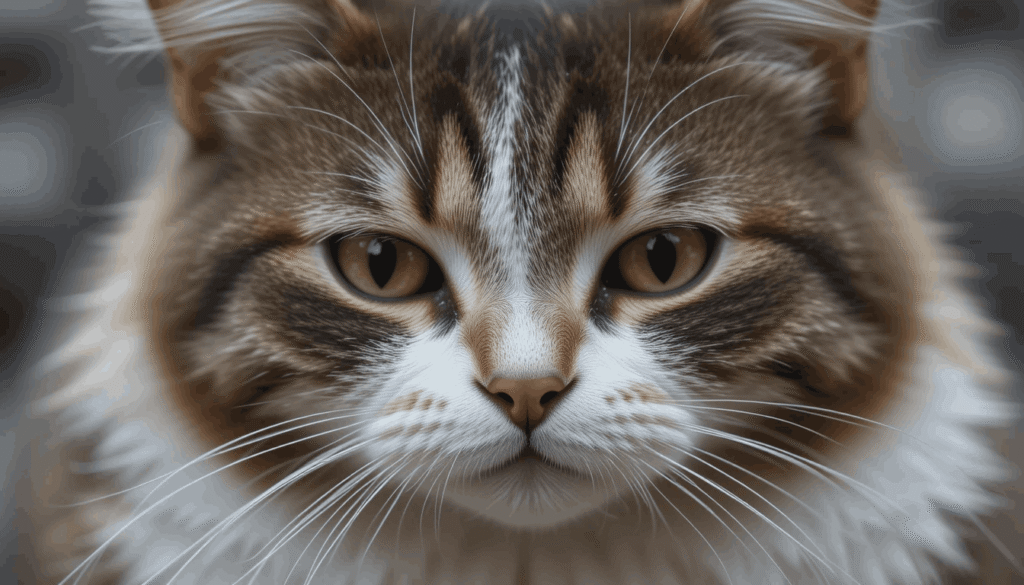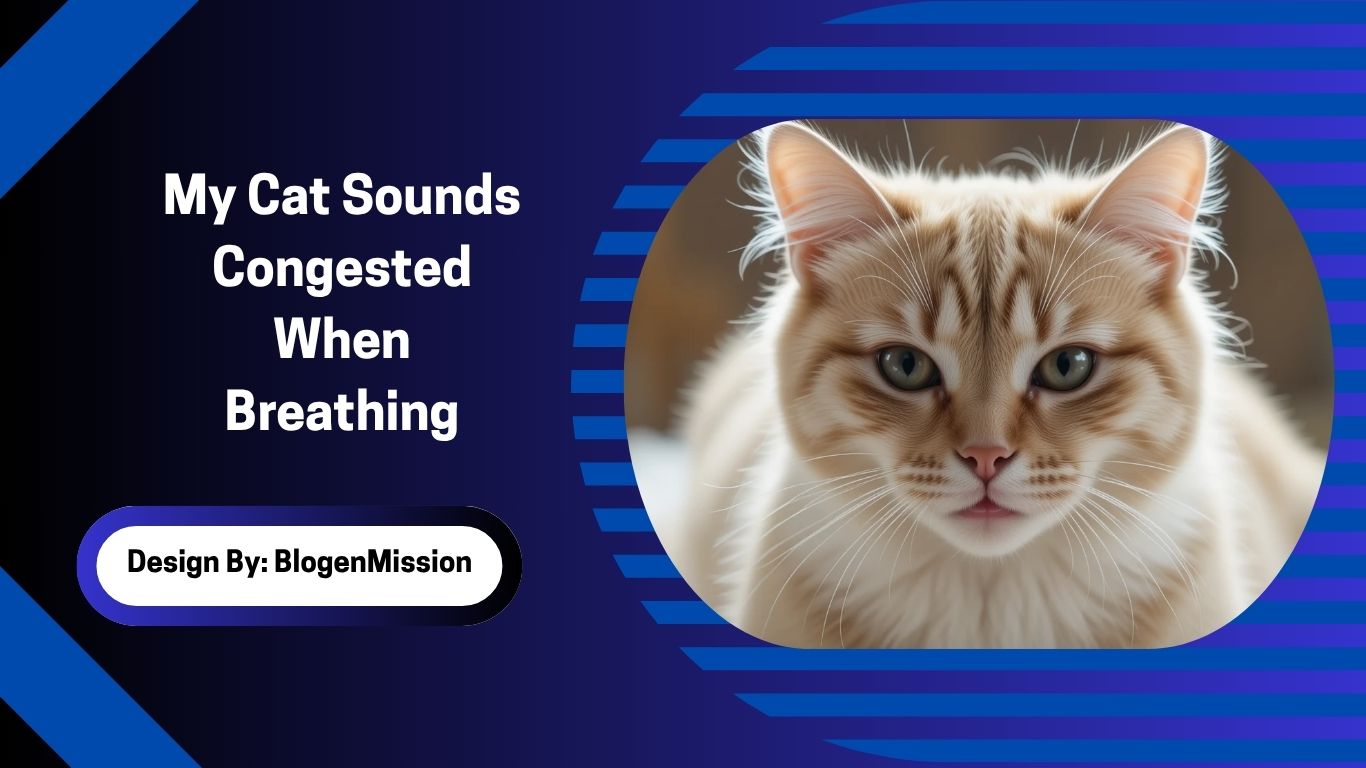If your cat sounds congested when breathing, it could be due to a respiratory infection, allergies, or more serious issues. Monitor symptoms, provide supportive care, and consult your vet if signs worsen.
If your cat sounds congested when breathing—snorting, wheezing, or making raspy noises—it can be alarming. This guide helps you understand what’s happening, the likely causes, safe treatments, and when to consult a vet.
What Does It Mean When a Cat Sounds Congested While Breathing?
Congested breathing in cats occurs when there’s restricted airflow through the nose, throat, or lungs. The sounds you hear may include:
- Snuffling or low-pitched snoring (called stertor)
- Wheezing or whistling (stridor)
- Noisy breathing during rest or sleep
Identifying whether the sound comes from the nose or throat can help determine the cause and urgency.
Common Reasons Why Cats Sound Congested

1. Upper Respiratory Infections (URIs)
Cats often get colds and flu-like viruses, particularly in multi-pet homes or shelters. These infections can cause sneezing, nasal discharge, and noisy breathing due to inflammation and mucus buildup.
2. Allergies and Environmental Irritants
Things like dust, mold, pollen, cigarette smoke, or strong cleaning agents may irritate your cat’s airway, leading to congestion-like breathing.
3. Dental Infections or Nasal Polyps
Severe tooth infections, particularly in the upper jaw, may spread toward the sinuses. Nasal polyps—non-cancerous growths—can also block airflow and create snorting or snoring sounds.
4. Feline Asthma or Bronchitis
Cats with asthma often breathe heavily or wheeze, especially after exercise or exposure to allergens. They may crouch low to the ground and extend their neck to breathe easier.
5. Airway Obstruction or Foreign Bodies
Congestion may result from structural issues such as an elongated soft palate, tumors, or even inhaled objects. These can partially block the airway and cause abnormal sounds.
6. Heart Disease or Fluid in the Lungs
Conditions that affect heart function can lead to fluid buildup in the lungs or chest cavity, making it difficult for your cat to breathe comfortably. Noisy or labored breathing may be one of the first signs.
When Is Congested Breathing in Cats an Emergency?
Contact your vet right away if your cat shows:
- Rapid breathing over 30 breaths per minute at rest
- Persistent open-mouth breathing
- Blue-tinged gums or tongue
- Sudden lethargy or weakness
- Loss of appetite or weight
- Green or yellow nasal discharge
- Loud or worsening breathing noises
These signs may indicate respiratory distress or a life-threatening condition.
At-Home Care for Mild Cat Congestion
If your cat is acting normal, eating, and not showing signs of distress, you can try supportive care:
- Run a humidifier near your cat’s bed
- Offer warm, wet food to keep them hydrated
- Keep the home free of smoke and strong scents
- Gently wipe nasal discharge with a warm cloth
- Allow your cat to rest and reduce stress
Avoid over-the-counter medications unless prescribed by a vet, as many are unsafe for cats.
Also Read: How Often Should Cats Get Rabies Shots – You Need to Know!
How Vets Diagnose Congested Breathing in Cats?
A veterinarian may perform:
- A physical exam and listen to breathing sounds
- Blood tests to check for infection or inflammation
- Nasal swabs for respiratory viruses or bacteria
- Dental inspection for hidden infections
- Imaging tests (X-ray, CT scan) to examine nasal passages or lungs
- Rhinoscopy (a camera scope) to look inside the nasal cavity
The treatment plan depends on the cause and may include medications, antibiotics, surgery, or allergy management.
Understanding Stertor vs. Stridor in Cats
| Type | Description | Area Affected | Common Causes |
| Stertor | Low-pitched, snore-like | Nose/throat | Mucus, nasal blockage, dental issues |
| Stridor | High-pitched, whistle-like | Larynx or windpipe | Asthma, tumors, foreign objects, collapse |
Stertor often occurs during sleep or rest and may be mild. Stridor, especially when combined with labored breathing, often signals more serious problems.
Track Symptoms to Help Your Vet
To help with diagnosis, keep a simple journal noting:
- Frequency and timing of the noisy breathing
- Any nasal or eye discharge
- Appetite, energy levels, and behavior
- Environmental triggers like cleaners, dust, or pollen
- Whether symptoms worsen at night or after activity
Bring these notes to your vet for a more accurate diagnosis and faster treatment.
FAQs:
1. Can stress cause my cat to sound congested when breathing?
Yes, stress can trigger or worsen respiratory symptoms in cats, especially those with underlying conditions like asthma. Stress may also lower immunity, making them more prone to respiratory infections or inflammation.
2. Should I worry if only one nostril is blocked in my cat?
A blockage in one nostril may indicate a polyp, tumor, or foreign object. While not always urgent, it warrants a vet visit, especially if accompanied by nasal discharge, sneezing, or noisy breathing.
3. How can I safely clean my cat’s nose at home?
Use a warm, damp cloth to gently wipe away nasal discharge. Avoid inserting anything into the nostrils. A saline mist made for pets may help, but consult your vet before use.
4. Is congested breathing in cats more common in certain breeds?
Yes, brachycephalic (flat-faced) breeds like Persians are more prone to breathing problems and congestion due to their narrow nasal passages. Regular monitoring and vet care are especially important for these cats.
5. Can food allergies make my cat sound congested?
Yes, some cats with food sensitivities may develop respiratory symptoms, including congestion. This can be due to inflammation or an immune response. An elimination diet may help identify and manage food-related issues.
Conclusion:
Congested breathing in cats can be caused by many factors, from harmless colds to serious underlying conditions like asthma or nasal obstructions. While mild cases may be managed at home with care and observation, persistent or severe symptoms require veterinary attention. Understanding the common causes, knowing when to act, and providing a clean, low-stress environment can support your cat’s recovery. Early intervention and regular health monitoring go a long way in ensuring your cat breathes easily and lives a healthy, comfortable life.
Related Post:
- Cat Food Canned – Ultimate Guide!
- Why Is My Dog Panting So Much At Night – Causes and Solutions for Canine Health!
- Why Is My Cat Not Drinking Water – Causes, Risks & Solutions!
